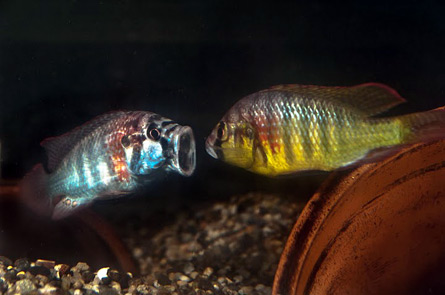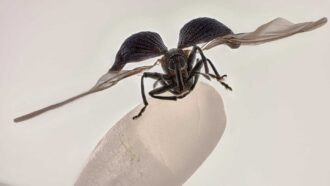Afraid of its own fishy reflection
A cichlid brain works differently when the fish attacks its mirror image.
Share this:
- Share via email (Opens in new window) Email
- Click to share on Facebook (Opens in new window) Facebook
- Click to share on X (Opens in new window) X
- Click to share on Pinterest (Opens in new window) Pinterest
- Click to share on Reddit (Opens in new window) Reddit
- Share to Google Classroom (Opens in new window) Google Classroom
- Click to print (Opens in new window) Print
Male cichlids are mainly freshwater fish. And they may chase after other fish who dare cross their path. A male cichlid will even lunge if that “other fish” happens to be himself. That is, some types of these cichlids will try to attack their own reflections in a mirror. Indeed, they’ll respond as aggressively as when they encounter a real opponent.
 |
|
Male cichlids get hostile when they meet a real male (shown here) or when they encounter their own reflection. But their reflection provokes activity in their brains that could be connected with fear.
|
| Todd Anderson |
Researchers from Stanford University recently studied male cichlids that fight their own reflections. And their new study suggests that the fish’s brain actually reacts differently to the real and the mirror fish. The team observed that the part of the brain associated with fear and other negative emotions becomes active when these fish fight their mirror images.
Julie K. Desjardins, who worked on the study, says it’s not clear whether the research is finding “fear.” That is, her team is not sure that the fish are afraid of themselves. Even if it’s not fear, the fish are having a negative response. It’s something besides the aggression that these fish usually show toward another fish, she told Science News.
She worked with Russell Fernald, also at Stanford. Their data are the first to show that a fish’s brain reacts differently when the fish sees its own reflection. That doesn’t mean, however, that the fish recognizes itself.
Scientists use mirrors to try to study the consciousness of animals. Previous studies have shown that great apes, elephants, dolphins and magpies (a type of bird) look into a mirror and know they see themselves, Diana Reiss told Science News. She is a scientist at Hunter College in New York City who tries to understand animal cognition, or how animals think. Reiss says not every animal knows its mirror self. Monkeys and fish, for example, don’t seem to recognize themselves in the mirror.
In the new study, Desjardins and Fernald did not observe a difference in the behaviors of fish going after other fish compared with fish going after their own reflections. But they found a difference in the fish’s brain, using a technique called immediate early gene (IEG) expression.
The scientists used it to watch genes in the fish that were associated with particular regions of the brain. Measuring IEG helped the scientists to determine which areas of the brain were more active than others. “It’s a kind of fishy MRI,” Desjardins told Science News. MRI stands for magnetic resonance imaging, a tool that gives scientists an idea of what’s going on inside the brain.
When a fish went after its own reflection, the scientists found that the fish brain was especially active in a region similar to the amygdala. In humans and other animals, the amygdala is associated with fear and other negative emotions.
When the male cichlids went after other fish, they didn’t have the same activity in their amygdala regions. This shows that their brains reacted differently when they looked themselves in the fishy face.
Using IEG expression to study fishy fear is new and unusual, but some older studies have shown similar results in other animals. Monkeys, for example, have not been shown to recognize themselves. They do, however, act differently around their own reflections than they do around other monkeys.
This experiment shows how mirrors can be used to study brain activity, even for animals that don’t recognize themselves.







